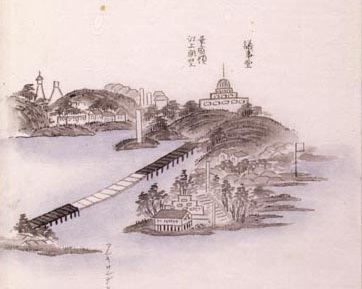10 Ways to Experience Japanese Culture around Washington, DC
November 06, 2015

Find ways to experience Japanese culture in and around Washington D.C.
-
The National Cherry Blossom Festival & Sakura Matsuri Japanese Street Festival
Image from http://www.nationalcherryblossomfestival.org/news/press-room/high-res-images/
The most famous Japanese-American event in the country, the National Cherry Blossom Festival has brought thousands of people to DC to celebrate Japanese-American relations. The trees were a gift from Japan to the US in 1912, and the festival begins with the lighting of the Japanese Stone Lantern, given to the US by Japan in 1954. The Cherry Blossom Festival includes a parade, lectures, dance exhibits, and many Japanese cultural events each year. Tickets to the opening ceremony are free, but must be reserved ahead of time. Watch the countdown to the peak bloom here.
The Sakura Matsuri Street Festival ends the Cherry Blossom Festival with a street fair and festival celebrating Japanese culture in downtown DC. Enjoy Japanese food, cultural lessons, dancing, pottery, technology, and crafts lessons at the Street Festival.
Consider applying to be a Cherry Blossom Festival Goodwill Ambassador, a competitive post open to college students and recent graduates to act as liaisons between the festival and the Japanese American community and Japanese Embassy.
Image from http://www.tankokaidc.org/about/washin-an.
The Urasenke Tea Ceremony Association of Washington, DC is a nonprofit dedicated to cultural and educational events about the Japanese tea ceremony. Every Thursday their tea room hosts an open house, in which visitors can experience and learn about the tea ceremony. Reservations are required. Several weekly events are available to members, with student memberships available.
Image from http://www.asia.si.edu/collections/japanese_highlights.asp
The Freer Gallery hosts the Smithsonian Institution’s Japanese Art collections which showcase four millennia of Japanese history. The museum features not just art, but also regularly shows Japanese films and performances, featuring not just classical movies and music, but also contemporary Japanese pop culture. Performances are typically free, but may require ticket reservations.
*Note that the Freer Gallery will be closed January 4, 2016 through the summer of 2017. While it’s closed, consider making the trek to Baltimore’s Walters Art Gallery, with its collections of Japanese Art and armor.
-
Check out Events at the Japanese Information and Culture Center
Image from https://picasaweb.google.com/110110203650069790184/OrigamiFunNight10242014#6075320205953059346
Recent JICC events have included origami nights, shodo calligraphy demonstrations, and painting and haiku competitions. The center is open during business hours and has ongoing walk-in exhibitions. The current exhibition features masterful origami works in honor of World Origami Days.
The JICC runs two calendars: a JICC events calendar, and a very thorough DC-area events calendar, both of which are regularly updated with Japanese cultural events around the area.
Image from https://www.bonsai-nbf.org/japanese-collection/
The National Bonsai and Penjing Museum is located at the National Arboretum, and supported by the National Bonsai Foundation. The museum is home to dozens of Japanese and American grown bonsai, complete with a Japanese stroll garden and exhibits of traditional Japanese homes. Of special interest is the Yamaki Pine, the oldest of the Japanese bonsai in the museum, and a tree that survived the atomic bomb blast in Hiroshima.
Note that the Bonsai and Penjing Museum has more limited hours than the Arboretum.
Image from http://www.washingtonian.com/articles/arts-events/hidden-gems-2014-invite-only/
The Ippakutei Teahouse, located behind the Embassy of Japan, has been called the best traditional teahouse outside of Japan, and one of Washington, DC’s hidden treasures. The Ippakutei Teahouse and Old Ambassador's Residence of the Embassy of Japan are open one to two times a year to public tours, often around the Cherry Blossom Festival. Make sure to keep checking back on the JICC website for the next opportunity!
The National Japanese American Memorial honors both those Japanese Americans who gave their lives during World War II, and those who were interned by the US government. Take time to read about the symbolism in each part of the site before visiting to fully appreciate the Memorial.
Image from https://en.wikipedia.org/wiki/Go_(game)
The game of go was first attested in China in the 4th century BCE, and appears to have reached Japan in the 5th and 6th centuries CE. Despite its relatively simple rules, its complex permutations can lead to addictive strategy and competition. While you could teach yourself, consider attending free community go events held by the Washington Go Association or the Takoma Park Intergenerational Strategy Games Club (call ahead to confirm), or even re-forming the UMD Go Club!
Image from https://en.wikipedia.org/wiki/Anime
The UMD Terrapin Anime Society meets discuss Japanese animation and encourage its appreciate among students. Stop by a club meeting to find out more!
The DC area has several chains that carry Japanese ingredients. One independent store, Hana Japanese Market specializes solely Japanese foods: stop by to explore new ingredients and try making Japanese foods yourself!
Bonus! Visit the Library of Congress Japanese Collections
Image from http://www.loc.gov/rr/asian/USCapital.html
View of the United States Capitol
from Journal and Sketches from
the Voyage to America
(Meriken kôkai nikki ryakuzu), 1860
From the Library of Congress, “The Asian Reading Room is the primary public access point for researchers seeking to use the Asian collections of the Library of Congress in the many languages of Asia. The reading room covers the area from the South Asian subcontinent and Southeast Asia to China, Japan, Korea, and Mongolia. With over 3 million books, periodicals and newspapers, a large number of manuscripts, and electronic media, the collections are the most comprehensive sources of Asian language materials outside of Asia.”
A competitive fellowship is available to help researchers interested in performing Asian studies research at the Library of Congress.

